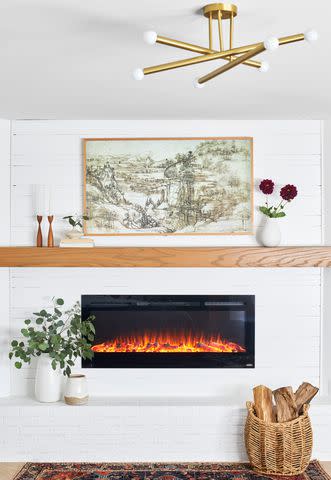Types of Fireplaces and the Pros and Cons of Each
Fireplaces aren't one-size-fits-all. Find the best model for your home and lifestyle.

Better Homes & Gardens / David Greer
Fireplaces are one of the most traditional features of a home. They provide a warm, inviting atmosphere, even when they’re completely decorative. Whether vintage or modern, a home’s biggest selling point could be a well-kept fireplace in a living room, dining room, or bedroom. A working fireplace, however, requires some TLC. With so many fireplace types to consider, it’s best to learn more about how each one works, as well as some common pros and cons of each model.

Kritsada Panichgul
Types of Wood-Burning Fireplaces
You might find a wood-burning fireplace already built into the structure of a historic or Colonial home. However, many custom-built homes are also enhanced by a traditional fireplace in a great room or family dining space. Wood-burning fireplaces offer warmth and ambiance. They are a natural focal point and a favorite gathering spot during harsh winters. These are some types of wood-burning fireplaces:
Open-Hearth Fireplace: These traditional fireplaces have a wide opening, without a glass cover, and frequently feature a stone or brick facade. The opening allows you to see the wood burning, making it a decorative feature of a room.
Single-Sided Fireplace: This conventional fireplace has only one windowpane or opening through which to see the fire.
See-Through or Double-Sided Fireplace: This newer model of wood-burning fireplace has a glass enclosure on both sides of a fireplace so that it can heat two rooms at the same time.
Wood-Burning Stove: A freestanding, steel, or cast-iron timber stove with a metal stove tube can act as a fireplace and warm your home, in addition to being a functional stove.
:
Pro: Traditional Appeal, Affordable Kindling
Many homeowners prefer the smell and warmth of a wood-burning fireplace. The cost of a wood-burning fireplace can be affordable if you live in a place where you can chop your own firewood and gather kindling from your surroundings.
Con: Fire Safety Is a Must
The area around a wood-burning fireplace must be clear of flammable materials. Additionally, the chimney will need to be in good condition before lighting a fire. Regular maintenance of the fireplace and chimney is essential. You'll also need a chimney liner in place to reduce the chance of fire and carbon monoxide fumes.

Jay Wilde
Types of Gas Fireplaces
Gas-fueled fireplaces offer many benefits. In comparison to traditional wood-burning fireplaces, gas fireplaces are more efficient and easier to maintain. They also produce less air pollution. These are some types of gas fireplaces:
Vent-Free Fireplace: These gas fireplaces are front-opening or linear. No vent is needed, but proper air ventilation is important. In some states, these cannot be installed in bedrooms.
B-Vent Fireplace: This fireplace uses a conventional chimney draft system to the roof. B-vent fireplaces are energy efficient.
Direct-Vent Fireplace: This model uses a two-wall system to vent air and exhaust. Direct-vent fireplaces come in many sizes, styles, and shapes to suit any home.
See-Through Gas Fireplaces: This luxurious gas fireplace type has a visible flame that can be seen from two rooms at the same time.
:
Pro: Reduced Emissions, Modern Appeal and Convenience
Gas inserts can be placed inside your existing wood-burning fireplace, adding modern style and convenience. Whereas all wood-burning fireplaces need a vent or exhaust, there are vent-free options for gas fireplaces. Gas fireplaces have minimal emissions thanks to purifying filters, eliminating the need for a chimney or flue structure.
Con: Design Limits and Cost
With any fireplace, there’s a risk of carbon monoxide and other toxic gases inside the home. Some states, like Massachusetts and California, have additional limits on where gas fireplaces can be installed. Some devices have an oxygen detection system, which turns off the fireplace when oxygen levels drop too low.
Gas inserts can be an easy way to modernize a traditional wood-burning fireplace. However, installation generally costs between $1,000 to $8,000. Vent-free varieties are less expensive than direct-vent gas inserts. Gas inserts must be inspected and serviced regularly to ensure they are operating safely and efficiently.

Adam Albright
Types of Electric Fireplaces
Electric fireplaces are modern and use LED lights instead of real flames. Absent of fire, these fireplaces are powered by electricity to produce heat. However, it is possible to use them just for the look without using the heating feature. Some electric fireplaces come with different flame styles and colors that provide a more aesthetically pleasing experience.
Electric fireplaces are also relatively inexpensive to operate. These are some types of electric fireplaces:
Wall-Mount Fireplace: These fireplaces can be attached or built into a wall and work with a normal household outlet. They come in both heated and not heated designs.
TV Stand or Mantel Electric Fireplace: Although it looks like a wood-burning fireplace and mantel, these electric fireplaces don't have a flame. Meant to mimic furniture, these electric fireplaces offer many styles and flame intensities that can be changed with just a click of a button.
:
Pro: Unbeatable Convenience, Low Cost
Electric fireplaces are incredibly convenient. They can be turned on and off with the push of a button and do not require any special ventilation. While they heat a room, they are cool to the touch, which makes them perfect for families with small kids. The cost of electric fireplaces is significantly lower than other options. They typically range between $300 and $1,000, though special features will cost more.
Con: Easy-to-Forget Maintenance
Electric fireplace inserts are also available and require very little maintenance. They can easily be installed by anyone, even those without any handy experience. However, it is vital to clean electric fireplaces regularly to prevent the buildup of dust and dirt. Because these fireplaces are so convenient, it can be easy to forget to perform care basics.
false
